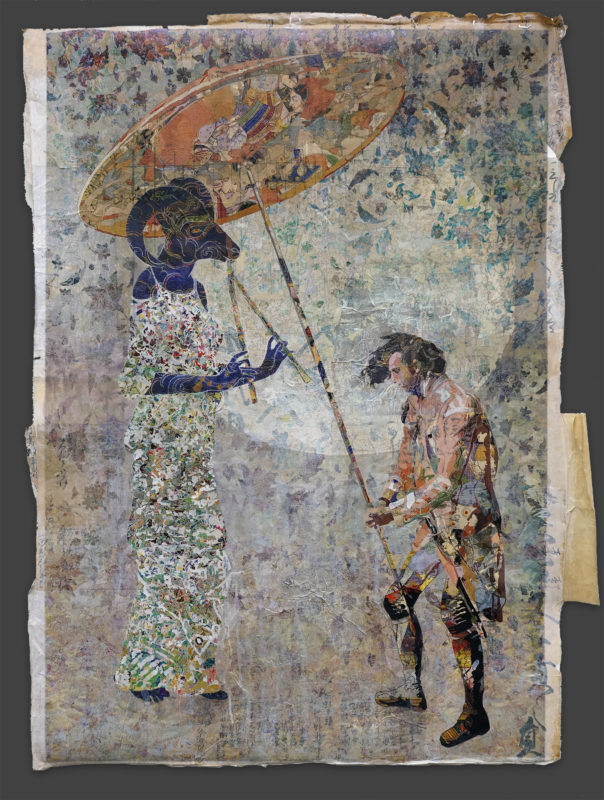
mixed media collage of antique Japanese papers on Arches rag with acrylic, UV acrylic and watercolor
42 x 31 in.
unique
(This work has sold.)
Aulos Echo was first exhibited in “I Forget I’m Human” at Peters Projects, Santa Fe, NM.
Outside the window
Sky and earth exchange silver.
In the moonlight I forget I’m human.
– Wang Xiaoni
In “I Forget I’m Human,” Donald and Era Farnsworth investigate and comment upon the relationship between humanity and the environment, with a particular focus on the intersection of myth and science and how those systems of understanding have shaped human values from ancient times to the present day. For centuries, diverse cultures living all over the planet have developed symbols and images to serve as a visual language articulating their understanding of humanity’s place in the universe. The Farnsworths’ recent works draw from this universal alphabet of symbols, motifs, and color, all invested by their human originators with a distinct meaning or spiritual significance. In particular, these works focus on notions of the sacred and valuable in the context of human culture and its relation to the environment. From ancient gods with the heads of animals to living, breathing endangered species; from the capitalistic fever for accumulated wealth to precious natural resources like clean air and water, what we value is evident not only in our behavior as a species, but in our symbolic and visual output: ie, the myths we make and the images that accompany them.
Since the earliest myths were conceived, the sun has symbolized the power of nature in humanity’s conception of its relationship to the environment and the sacred. Even our moon, which gives off no light of its own, is dependent on the sun – without which there would be no moonlight. From the ancient Indian sages who associated the sun with enlightenment (eventually inspiring the halo in Christian art) to the contemporary issue of global warming, the sun is a literal and symbolic representation of both the nurturing and the destructive powers of the environment. As such, it is not surprising that in artworks from all over the world and across recorded time, a potent symbol of the relationship between humanity and the environment can be found in the form of the umbrella. A nearly ubiquitous presence in Buddhist iconography, the umbrella is assigned a powerful spiritual significance in various traditions; it also holds a more pragmatic appeal, one which even the most secular-minded individuals, those simply seeking relief from rising temperatures or refuge from an unexpected downpour, can surely understand. Several of these works draw upon the umbrella as a symbol of humanity’s coexistence with nature as we strive, regardless of epoch or nationality, for a balanced and spiritually meaningful existence.
Not only the content, but also the techniques used to create the works in this exhibition reflect this desire to find common ground across centuries and borders. Nearly all of the compositions in “I Forget I’m Human” include multiple layers of both hand-painted and digitally generated elements, creating a palimpsest-like effect that echoes the layers, patinas, and weathered wabi-sabi of works that have survived from ancient times while also incorporating contemporary digital processes. The Deluge Thangka tapestry uses a medium older than oil on canvas (weaving – albeit updated by 19th-century Jacquard and 21st-century digital color matching technologies) and a flood myth that predates the Bible to illustrate the pressing contemporary problem of global warming. The Farnsworths’ Art Notes series ‘recycles’ and re-imagines one dollar bill notes, re-envisioning the “Almighty Dollar” as a site wherein to celebrate heroes of creativity and conservation and to playfully castigate polluters and oligarchs. A series of works depicting therianthropic (animal-human hybrid) deities harkens back to those appearing in the earliest surviving human artworks while also incorporating elements from Buddhist, Hindu, Judeo-Christian, Islamic and Jungian iconographies. Early humans thought of these supernatural “composite” beings as intermediaries between life on earth and the spirit world; like the umbrella, they serve as a symbolic link between two realms, suggesting a harmonious coexistence – a unity – of humanity and our environment. It is this unity – a kind of spiritual-ecological understanding, what the Quakers would call a “right relationship” with the environment – that these works attempt to suggest and inspire.
-Nick Stone
show prices
Prices and availability are subject to change without notice.The copyright of all art images belongs to the individual artists and Magnolia Editions, Inc.
©2003-2025 Magnolia Editions, Inc. All rights reserved. contact us
